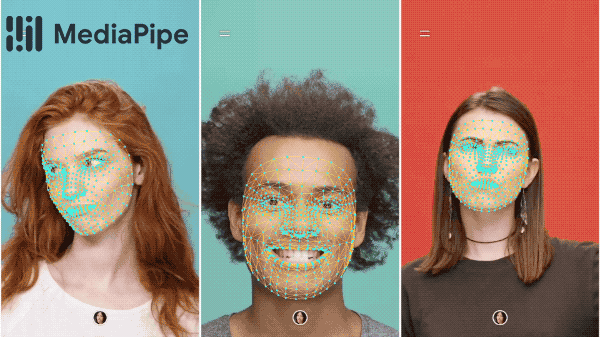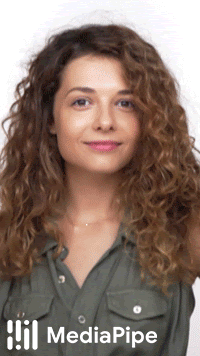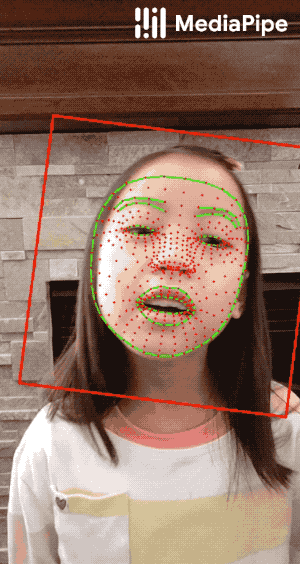16 KiB
| layout | title | parent | nav_order |
|---|---|---|---|
| default | Face Mesh | Solutions | 2 |
MediaPipe Face Mesh
{: .no_toc }
- TOC {:toc}
Overview
MediaPipe Face Mesh is a face geometry solution that estimates 468 3D face landmarks in real-time even on mobile devices. It employs machine learning (ML) to infer the 3D surface geometry, requiring only a single camera input without the need for a dedicated depth sensor. Utilizing lightweight model architectures together with GPU acceleration throughout the pipeline, the solution delivers real-time performance critical for live experiences.
Additionally, the solution is bundled with the Face Geometry module that bridges the gap between the face landmark estimation and useful real-time augmented reality (AR) applications. It establishes a metric 3D space and uses the face landmark screen positions to estimate face geometry within that space. The face geometry data consists of common 3D geometry primitives, including a face pose transformation matrix and a triangular face mesh. Under the hood, a lightweight statistical analysis method called Procrustes Analysis is employed to drive a robust, performant and portable logic. The analysis runs on CPU and has a minimal speed/memory footprint on top of the ML model inference.
 |
|---|
| Fig 1. AR effects utilizing facial surface geometry. |
ML Pipeline
Our ML pipeline consists of two real-time deep neural network models that work together: A detector that operates on the full image and computes face locations and a 3D face landmark model that operates on those locations and predicts the approximate surface geometry via regression. Having the face accurately cropped drastically reduces the need for common data augmentations like affine transformations consisting of rotations, translation and scale changes. Instead it allows the network to dedicate most of its capacity towards coordinate prediction accuracy. In addition, in our pipeline the crops can also be generated based on the face landmarks identified in the previous frame, and only when the landmark model could no longer identify face presence is the face detector invoked to relocalize the face. This strategy is similar to that employed in our MediaPipe Hands solution, which uses a palm detector together with a hand landmark model.
The pipeline is implemented as a MediaPipe graph that uses a face landmark subgraph from the face landmark module, and renders using a dedicated face renderer subgraph. The face landmark subgraph internally uses a face_detection_subgraph from the face detection module.
Note: To visualize a graph, copy the graph and paste it into MediaPipe Visualizer. For more information on how to visualize its associated subgraphs, please see visualizer documentation.
Models
Face Detection Model
The face detector is the same BlazeFace model used in MediaPipe Face Detection. Please refer to MediaPipe Face Detection for details.
Face Landmark Model
For 3D face landmarks we employed transfer learning and trained a network with several objectives: the network simultaneously predicts 3D landmark coordinates on synthetic rendered data and 2D semantic contours on annotated real-world data. The resulting network provided us with reasonable 3D landmark predictions not just on synthetic but also on real-world data.
The 3D landmark network receives as input a cropped video frame without additional depth input. The model outputs the positions of the 3D points, as well as the probability of a face being present and reasonably aligned in the input. A common alternative approach is to predict a 2D heatmap for each landmark, but it is not amenable to depth prediction and has high computational costs for so many points. We further improve the accuracy and robustness of our model by iteratively bootstrapping and refining predictions. That way we can grow our dataset to increasingly challenging cases, such as grimaces, oblique angle and occlusions.
You can find more information about the face landmark model in this paper.
Face Geometry Module
The Face Landmark Model performs a single-camera face landmark detection in the screen coordinate space: the X- and Y- coordinates are normalized screen coordinates, while the Z coordinate is relative and is scaled as the X coodinate under the weak perspective projection camera model. This format is well-suited for some applications, however it does not directly enable the full spectrum of augmented reality (AR) features like aligning a virtual 3D object with a detected face.
The Face Geometry module moves away from the screen coordinate space towards a metric 3D space and provides necessary primitives to handle a detected face as a regular 3D object. By design, you'll be able to use a perspective camera to project the final 3D scene back into the screen coordinate space with a guarantee that the face landmark positions are not changed.
Key Concepts
Metric 3D Space
The Metric 3D space established within the Face Geometry module is a right-handed orthonormal metric 3D coordinate space. Within the space, there is a virtual perspective camera located at the space origin and pointed in the negative direction of the Z-axis. In the current pipeline, it is assumed that the input camera frames are observed by exactly this virtual camera and therefore its parameters are later used to convert the screen landmark coordinates back into the Metric 3D space. The virtual camera parameters can be set freely, however for better results it is advised to set them as close to the real physical camera parameters as possible.
 |
|---|
| Fig 3. A visualization of multiple key elements in the Metric 3D space. |
Canonical Face Model
The Canonical Face Model is a static 3D model of a human face, which follows the 468 3D face landmark topology of the Face Landmark Model. The model bears two important functions:
- Defines metric units: the scale of the canonical face model defines the metric units of the Metric 3D space. A metric unit used by the default canonical face model is a centimeter;
- Bridges static and runtime spaces: the face pose transformation matrix is - in fact - a linear map from the canonical face model into the runtime face landmark set estimated on each frame. This way, virtual 3D assets modeled around the canonical face model can be aligned with a tracked face by applying the face pose transformation matrix to them.
Components
Geometry Pipeline
The Geometry Pipeline is a key component, which is responsible for estimating face geometry objects within the Metric 3D space. On each frame, the following steps are executed in the given order:
- Face landmark screen coordinates are converted into the Metric 3D space coordinates;
- Face pose transformation matrix is estimated as a rigid linear mapping from the canonical face metric landmark set into the runtime face metric landmark set in a way that minimizes a difference between the two;
- A face mesh is created using the runtime face metric landmarks as the vertex positions (XYZ), while both the vertex texture coordinates (UV) and the triangular topology are inherited from the canonical face model.
The geometry pipeline is implemented as a MediaPipe calculator. For your convenience, the face geometry pipeline calculator is bundled together with the face landmark module into a unified MediaPipe subgraph. The face geometry format is defined as a Protocol Buffer message.
Effect Renderer
The Effect Renderer is a component, which serves as a working example of a face effect renderer. It targets the OpenGL ES 2.0 API to enable a real-time performance on mobile devices and supports the following rendering modes:
- 3D object rendering mode: a virtual object is aligned with a detected face to emulate an object attached to the face (example: glasses);
- Face mesh rendering mode: a texture is stretched on top of the face mesh surface to emulate a face painting technique.
In both rendering modes, the face mesh is first rendered as an occluder straight into the depth buffer. This step helps to create a more believable effect via hiding invisible elements behind the face surface.
The effect renderer is implemented as a MediaPipe calculator.
 |
|---|
| Fig 4. An example of face effects rendered by the Face Geometry Effect Renderer. |
Example Apps
Please first see general instructions for Android, iOS and desktop on how to build MediaPipe examples.
Note: To visualize a graph, copy the graph and paste it into MediaPipe Visualizer. For more information on how to visualize its associated subgraphs, please see visualizer documentation.
Face Landmark Example
Face landmark example showcases real-time, cross-platform face landmark detection. For visual reference, please refer to Fig. 2.
Mobile
- Graph:
mediapipe/graphs/face_mesh/face_mesh_mobile.pbtxt - Android target:
(or download prebuilt ARM64 APK)
mediapipe/examples/android/src/java/com/google/mediapipe/apps/facemeshgpu:facemeshgpu - iOS target:
mediapipe/examples/ios/facemeshgpu:FaceMeshGpuApp
Tip: Maximum number of faces to detect/process is set to 1 by default. To change
it, for Android modify NUM_FACES in
MainActivity.java,
and for iOS modify kNumFaces in
FaceMeshGpuViewController.mm.
Desktop
- Running on CPU
- Running on GPU
Tip: Maximum number of faces to detect/process is set to 1 by default. To change
it, in the graph file modify the option of ConstantSidePacketCalculator.
Face Effect Example
Face effect example showcases real-time mobile face effect application use case for the Face Mesh solution. To enable a better user experience, this example only works for a single face. For visual reference, please refer to Fig. 4.
Mobile
- Graph:
mediapipe/graphs/face_effect/face_effect_gpu.pbtxt - Android target:
(or download prebuilt ARM64 APK)
mediapipe/examples/android/src/java/com/google/mediapipe/apps/faceeffect - iOS target:
mediapipe/examples/ios/faceeffect
Resources
- Google AI Blog: Real-Time AR Self-Expression with Machine Learning
- TensorFlow Blog: Face and hand tracking in the browser with MediaPipe and TensorFlow.js
- Google Developers Blog: MediaPipe 3D Face Transform
- Paper: Real-time Facial Surface Geometry from Monocular Video on Mobile GPUs (poster)
- Canonical face model: FBX, OBJ, UV visualization
- Models and model cards
